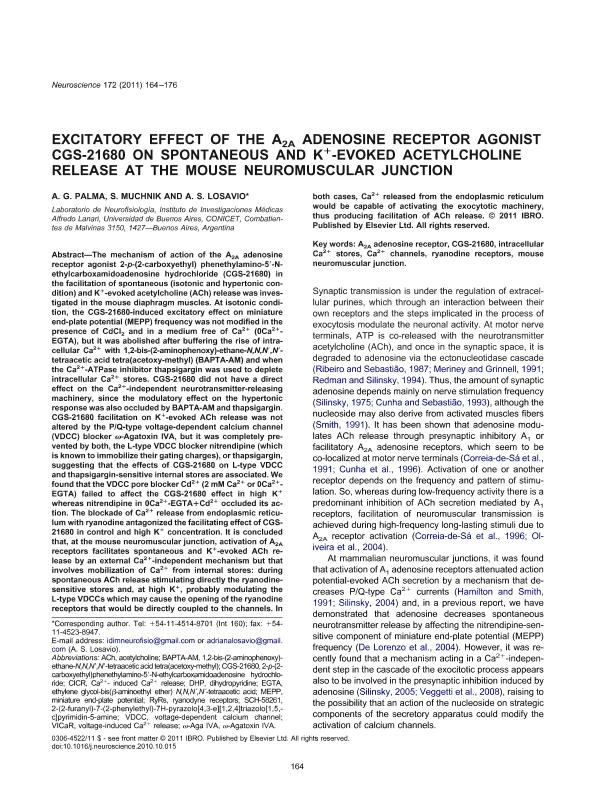Mostrar el registro sencillo del ítem
dc.contributor.author
Palma, Alejandra Graciela

dc.contributor.author
Muchnik, Salomon

dc.contributor.author
Losavio, Adriana Silvia

dc.date.available
2019-01-07T19:15:17Z
dc.date.issued
2011-01
dc.identifier.citation
Palma, Alejandra Graciela; Muchnik, Salomon; Losavio, Adriana Silvia; Excitatory effect of the A2A adenosine receptor agonist CGS-21680 on spontaneous and K+-evoked acetylcholine release at the mouse neuromuscular junction; Pergamon-Elsevier Science Ltd; Neuroscience; 172; 1-2011; 164-176
dc.identifier.issn
0306-4522
dc.identifier.uri
http://hdl.handle.net/11336/67593
dc.description.abstract
The mechanism of action of the A2A adenosine receptor agonist 2-p-(2-carboxyethyl) phenethylamino-5'-N-ethylcarboxamidoadenosine hydrochloride (CGS-21680) in the facilitation of spontaneous (isotonic and hypertonic condition) and K+-evoked acetylcholine (ACh) release was investigated in the mouse diaphragm muscles. At isotonic condition, the CGS-21680-induced excitatory effect on miniature end-plate potential (MEPP) frequency was not modified in the presence of CdCl2 and in a medium free of Ca2+ (0Ca2+-EGTA), but it was abolished after buffering the rise of intracellular Ca2+ with 1,2-bis-(2-aminophenoxy)-ethane-N,N,N',N'-tetraacetic acid tetra(acetoxy-methyl) (BAPTA-AM) and when the Ca2+-ATPase inhibitor thapsigargin was used to deplete intracellular Ca2+ stores. CGS-21680 did not have a direct effect on the Ca2+-independent neurotransmitter-releasing machinery, since the modulatory effect on the hypertonic response was also occluded by BAPTA-AM and thapsigargin. CGS-21680 facilitation on K+-evoked ACh release was not altered by the P/Q-type voltage-dependent calcium channel (VDCC) blocker ω-Agatoxin IVA, but it was completely prevented by both, the L-type VDCC blocker nitrendipine (which is known to immobilize their gating charges), or thapsigargin, suggesting that the effects of CGS-21680 on L-type VDCC and thapsigargin-sensitive internal stores are associated. We found that the VDCC pore blocker Cd2+ (2 mM Ca2+ or 0Ca2+-EGTA) failed to affect the CGS-21680 effect in high K+ whereas nitrendipine in 0Ca2+-EGTA+Cd2+ occluded its action. The blockade of Ca2+ release from endoplasmic reticulum with ryanodine antagonized the facilitating effect of CGS-21680 in control and high K+ concentration. It is concluded that, at the mouse neuromuscular junction, activation of A2A receptors facilitates spontaneous and K+-evoked ACh release by an external Ca2+-independent mechanism but that involves mobilization of Ca2+ from internal stores: during spontaneous ACh release stimulating directly the ryanodine-sensitive stores and, at high K+, probably modulating the L-type VDCCs which may cause the opening of the ryanodine receptors that would be directly coupled to the channels. In both cases, Ca2+ released from the endoplasmic reticulum would be capable of activating the exocytotic machinery, thus producing facilitation of ACh release.
dc.format
application/pdf
dc.language.iso
eng
dc.publisher
Pergamon-Elsevier Science Ltd

dc.rights
info:eu-repo/semantics/openAccess
dc.rights.uri
https://creativecommons.org/licenses/by-nc-sa/2.5/ar/
dc.subject
A2a Adenosine Receptor
dc.subject
Ca2+ Channels
dc.subject
Cgs-21680
dc.subject
Intracellular Ca2+ Stores
dc.subject
Mouse Neuromuscular Junction
dc.subject
Ryanodine Receptors
dc.subject.classification
Neurociencias

dc.subject.classification
Medicina Básica

dc.subject.classification
CIENCIAS MÉDICAS Y DE LA SALUD

dc.title
Excitatory effect of the A2A adenosine receptor agonist CGS-21680 on spontaneous and K+-evoked acetylcholine release at the mouse neuromuscular junction
dc.type
info:eu-repo/semantics/article
dc.type
info:ar-repo/semantics/artículo
dc.type
info:eu-repo/semantics/publishedVersion
dc.date.updated
2019-01-07T13:56:41Z
dc.journal.volume
172
dc.journal.pagination
164-176
dc.journal.pais
Estados Unidos

dc.description.fil
Fil: Palma, Alejandra Graciela. Consejo Nacional de Investigaciones Científicas y Técnicas. Oficina de Coordinación Administrativa Houssay. Instituto de Investigaciones Médicas. Universidad de Buenos Aires. Facultad de Medicina. Instituto de Investigaciones Médicas; Argentina. Universidad de Buenos Aires. Facultad de Medicina. Departamento de Ciencias Fisiológicas. Laboratorio de Neurofisiología; Argentina
dc.description.fil
Fil: Muchnik, Salomon. Consejo Nacional de Investigaciones Científicas y Técnicas. Oficina de Coordinación Administrativa Houssay. Instituto de Investigaciones Médicas. Universidad de Buenos Aires. Facultad de Medicina. Instituto de Investigaciones Médicas; Argentina. Universidad de Buenos Aires. Facultad de Medicina. Departamento de Ciencias Fisiológicas. Laboratorio de Neurofisiología; Argentina
dc.description.fil
Fil: Losavio, Adriana Silvia. Consejo Nacional de Investigaciones Científicas y Técnicas. Oficina de Coordinación Administrativa Houssay. Instituto de Investigaciones Médicas. Universidad de Buenos Aires. Facultad de Medicina. Instituto de Investigaciones Médicas; Argentina. Universidad de Buenos Aires. Facultad de Medicina. Departamento de Ciencias Fisiológicas. Laboratorio de Neurofisiología; Argentina
dc.journal.title
Neuroscience

dc.relation.alternativeid
info:eu-repo/semantics/altIdentifier/url/http://www.sciencedirect.com/science/article/pii/S030645221001345X
dc.relation.alternativeid
info:eu-repo/semantics/altIdentifier/doi/https://doi.org/10.1016/j.neuroscience.2010.10.015
Archivos asociados
